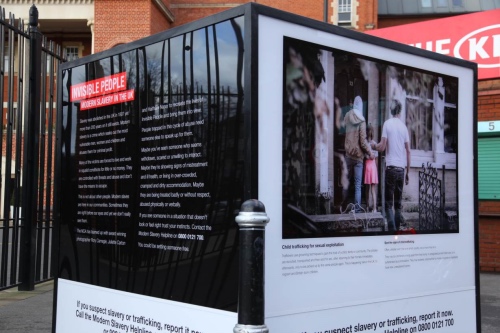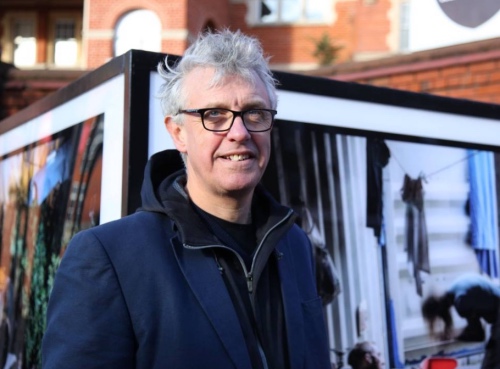

Top – The “Invisible People” exhibition on display in south London; Below – Photographer Rory Carnegie in front of his work at the exhibition. PICTURES: Cormac O’Brien/Thomson Reuters Foundation
A woman is strewn on a dirty mattress wrapped in a dishevelled leopard print dress, wearing a short blue wig. A butcher clad in a blood-stained apron hacks into an animal carcass.
These are just two of the striking images in an exhibition entitled “Invisible People” launched in London on Friday by the National Crime Agency (NCA), which will travel around Britain to raise awareness of the hidden crime of modern slavery.
“Most members of the public, not unreasonably, think that slavery was a crime that was abolished over 200 years ago,” Will Kerr, director of vulnerabilities for the NCA, told the Thomson Reuters Foundation.
“There are thousands of victims of modern slavery in every town and city across the UK.”
Kerr hopes the exhibition of haunting photographs mounted on illuminated cubes, will raise awareness and generate a public debate about the crime which ranges from sexual exploitation to forced manual labour and domestic servitude.
At least 13,000 people across Britain are estimated by the government to be victims of modern slavery – but police say the true figure could be in the tens of thousands with slavery operations on the rise.
Britain is viewed as being at the forefront of global efforts to tackle the crime, having passed the Modern Slavery Act in 2015.
The law introduced life sentences for traffickers, offered better protection for people at risk of being enslaved, and forced companies to check their supply chains for forced labour.
“I think some of the photos are quite harrowing,” said 26-year-old Lucy Allen, who passed by the outdoor exhibition in south London.
“I think this kind of thing will definitely familiarise people with modern slavery and trafficking. It’s something people don’t know enough about.”
About 40.3 million people were estimated to be living as slaves in 2016 – mostly women and girls – in forced labour and forced marriages, according to the U.N. International Labour Organization (ILO) and human rights group Walk Free Foundation.
“Historically we knew who slaves were, they wore chains and they were restricted. With modern slavery it’s much more insidious – it goes under the radar,” said Rory Carnegie, one of the exhibition’s photographers.
For Carnegie, it was important that he portrayed some level of dignity in his portraits. Without it those being trafficked were at risk of becoming “empty people”, he said.
His photos also depict the commonplace, everyday nature of the crime, which thrives in plain sight.
“I want people to be moved, I want some emotional response,” he told the Thomson Reuters Foundation.
The NCA leads the UK law enforcement response to modern slavery and human trafficking. There are currently more than 500 live policing operations targeting the threat, it said.
The exhibition will tour cities across Britain including Glasgow, Lincoln, Bristol and Cardiff – shown in public spaces such as shopping malls and high streets to draw attention to the crime.






